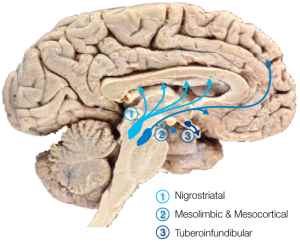

MedFriendly®


Dopamine Pathways of the Brain
Dopamine is a chemical messenger in the brain that is
important for slowing down movements, causing
pleasurable sensations, and other important functions.
There are four main dopamine pathways in the brain:
the nigrostriatal, mesocortical, mesolimbic, and
tuberoinfundibular pathways. The nigrostriatal pathway
is a pathway in the brain that connects the substantia
nigra with the striatum. The substantia nigra is a dark
area in the lower part of the brain that contains
dopamine, a chemical messenger that is important for
movement. The striatum is an area in the lower part of
the brain that is important for movement.
The dopamine pathways.
FEATURED BOOK: Dopamine Handbook
The striatum is an area in the lower part of the brain that is important for movement. The
nigrostriatal pathway was given its name because it connects these two areas. That is,
"nigro" refers to the substantia nigra, and "striatal" refers to the striatum. Nigrostriatal
comes from the Latin word "niger" meaning "black," (because the substantia nigra
appears black) and the Latin word "stria" meaning "striped"(because the striatum appears
striped).
The mesocortical pathway is a pathway in the brain that connects the midbrain ventral
tegmental area (an area in the lower part of the brain) to the limbic system (an area near
the edge of the middle part of the brain that is important for producing emotions). This
pathway is thought to bring about positive and negative psychotic symptoms.
"Where Medical Information is Easy to Understand"™
Positive psychotic symptoms are exaggerated experiences such as
seeing or hearing things that are not really present. Negative
psychotic symptoms are diminished experiences such as not
moving or speaking much. The mesocortical pathway is also thought
to be important for bringing about cognitive side effects in reaction
to a type of antipsychotic medications known as neuroleptics. The
word "mesolimbic" comes from the Greek word "meso," which
means "middle" (in this case it refers to midbrain) and the word
"cortical" comes from the Latin word "cortex", meaning "bark"
(referring to an outer part, like the bark of a tree). In this case, the
word "cortical" refers to the fact that the pathway goes to the limbic
cortical system.
The mesolimbic pathway is a pathway in the brain that connects the midbrain ventral tegmental area (an
area in the lower part of the brain) to the nucleus accumbens. The nucleus accumbens is a part of the
brain thought to be responsible for pleasurable feelings (particularly during drug abuse), delusions (false
beliefs, despite clear evidence to the contrary of those beliefs), and hallucinations (sensations that are
not really present). The chemical messenger, dopamine, travels along the mesolimbic pathway. The word
"mesolimbic" comes from the Greek word "meso," meaning "middle," (in this case it refers to midbrain) and
the word "limbic" comes from the word the Latin word "limbus," meaning "a border." In this case, the word
"limbic" refers to the fact that the pathway goes to the limbic system.
The tuberoinfundibular pathway is a pathway in the brain that connects the hypothalamus to the anterior
pituitary gland. The hypothalamus is an area in brain that is important for many bodily functions such as
sleep, appetite, and temperature control. The anterior pituitary gland is the front part of the pituitary gland.
The pituitary gland is an area in the brain that secretes (forms and gives off) chemicals known as
hormones. The tuberoinfundibular pathway controls the secretion of prolactin (a hormone important for
breast development and breast milk production). The neurotransmitter (a chemical messenger), dopamine,
travels along the tuberoinfundibular pathway. The word "tuberoinfundibular" comes from the Latin word
"tuber," meaning "a swelling," and the Latin word, "infundibulum," meaning "a funnel." Thus,
tuberoinfundibular refers to the pathway from a funnel shaped area on the bottom of the hypothalamus to
the swollen-shaped anterior pituatary gland.















